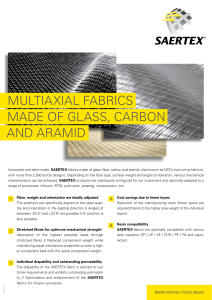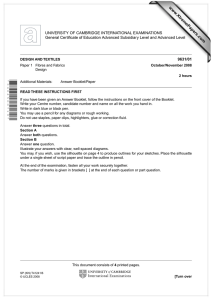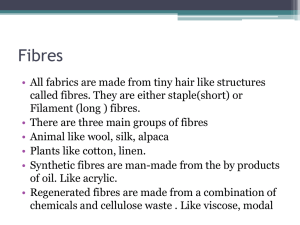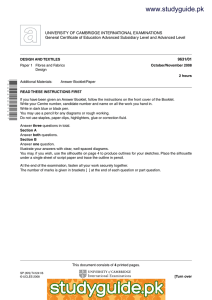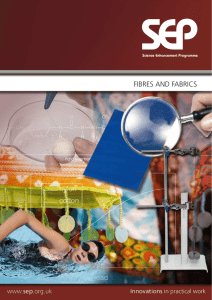Smart Materials and other bit and bobs!
advertisement
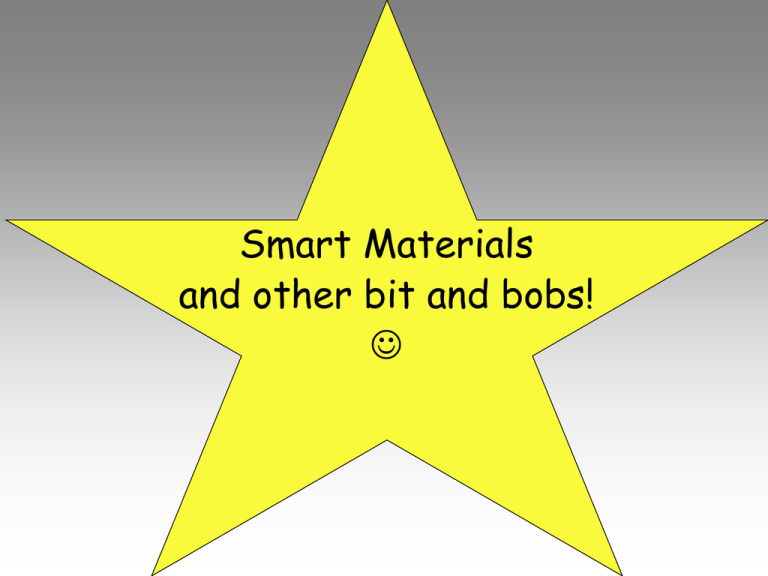
Smart Materials and other bit and bobs! What are Smart Materials? • Smart materials are materials that have one or more properties that can be significantly altered in a controlled fashion by external stimuli. Examples include stress, temperature, moisture, pH, electric or magnetic fields. Examples! Burton Snowboards wanted to develop a system to make it easier for snowboarders to listen to music (on a personal stereo) while boarding. They approached Softswitch Ltd to develop a electronic textile control pad for the Apple iPod system, which could be integrated into the sleeve of a Burton snowboarding jacket. The successful development of this wearable electronic system, involving the use of electrically conductive polymers, yarns and fabrics was named as one of Time Magazine's Coolest Inventions. Made of soft, washable fabric, woven with optical and electrical fibres into it, the ‘Smart shirt’ monitors the wearer’s heart rate, body temperature, respiration and a host of other vital functions. The information can be relayed wirelessly to doctors or personal trainers. Future applications include shirts for parental use to monitor babies and for military use to provide a trapped soldier’s exact location and give support units exact information about wounds. Examples you may have already seen?! These examples can be found in shops all around the country! Kevlar Kevlar is a versatile material which is strong, tough, stiff, high-melting and well suited for uses such as radial tyres, heator flame-resistant fabrics, and bulletproof clothing Carbon Fibre Carbon Fibre is used to reinforce composite materials. Carbon fibre is one of the for most leading materials used in F1 car production. it has been used since the 1960's Micro encapsulated fabrics Scents and smells can be added to fibres that can be released slowly – here’s an example of a child’s toy that has been fused with Chocolate scent – more aroma is released through heat. Other examples include the scratch and sniff T-shirts and packaging. Fabrics you should be aware of! • Polartec – made from recycled Polyester (plastic drinks bottles). Its light-weight and breathable • Gore-tex – is a bonded fabric that combined with other fabrics in thin layers provides exceptional properties including Wind/water proofing. It will also let the skin breath so is excellent for outdoor protective clothing! • Neoprene – is a man made fabric, used for wetsuits and other water sports attire. Has a stiff, body hugging quality that seals body heat in for protection Remember further examples can be found in your revisions guides pg 18 – 19! Just to recap! Remember you will need to know about fibres and fabrics…… What is a regenerated fabric???? What are natural fibres and what makes them so good??? What is a synthetic fabric ……..and why are there environmental implications with different fibres / fabrics? Miss Bones guide to getting it right! It is likely that a question will pop up on smart materials and fabrics therefore take my advice and really revise 4 good examples of smart fabrics – think about why they are good, the types of properties they have and where they have or could be used. I would also be prepared to know about different fibres/fabrics Just make sure you know all the natural fibres and at least 3 examples of regenerated and synthetic fibres too! Test yourselves with the GCSE Bite size revision guides – they are quite good!




